YouTube is one of the top platforms that comes to mind when it comes to monetizing your online video content as a creator. However, unpredictable algorithm changes, a limited content format, and limited control over content and community often push creators to seek alternative content monetization platforms.
If that’s the case for you, that’s fine. There are several video monetization platforms with similar revenue opportunities as YouTube. And if you’re not a video creator, there’s no need to worry either. We’ll cover a wide variety of alternative monetization platforms for other content types and formats.
Skip ahead:
- Table of contents
- Choosing the right YouTube monetization alternatives
- YouTube monetization alternatives FAQs
TL;DR
Here’s a quick look at the creator platforms we discussed in this article.
| Best For | Pros | Earning potential | |
| Monetizing online courses and communities |
|
| |
| Social media influencers |
|
| |
| Photographers and videographers |
| 15 – 45% commission on every image | |
| Video content creators with membership communities |
|
| |
| Video course creators |
|
| |
| Micro-influencers with membership communities |
|
| |
| Selling videos online |
|
| |
| Selling community subscriptions |
|
| |
| Content streaming |
|
| |
| Monetizing communities |
|
| |
| Smaller creators who want to monetize their content |
|
| |
| Sharing and monetizing written content |
|
|
1. Thinkific: Best monetization platform for educational content creators

Thinkific is a popular course creation platform that YouTube creators often use to help monetize their expertise. The user-friendly platform will let you create a custom website for your content, incorporate live lessons and events, and host community spaces for your viewers. As for your video content, Thinkific offers unlimited video hosting on all plans, so you don’t have to worry about running out of space or paying for more.
Pros
- Thinkific offers a 14-day free trial across all plans, allowing you to start earning with zero course creation platform fees.
- It offers everything you need to launch successful online courses on a single platform.
- It also offers student engagement tools like quizzes and gamification to improve the overall learning experience.
Cons
- Thinkific doesn’t have a marketplace where you can list and sell your course.
- There’s no free plan, but you can get started with a free trial.
Earning potential
Compared to other digital product platforms on this list, Thinkific is incredibly affordable. The course creation platform offers 4 plans: Free ($0), Basic ($36), Start ($99), and Grow ($199). All plans include community features, unlimited students, and customer support.
Regarding monetization models, creators can offer one-time sales, memberships, pre-sales, coupons and discounts, free trials, bundles, and more. They also boast a 0% transaction fee, which means creators can start selling their video content on the Free plan without any transaction fees or monthly plan payments, making your earning potential virtually limitless.
2. TikTok: Best for social media influencers
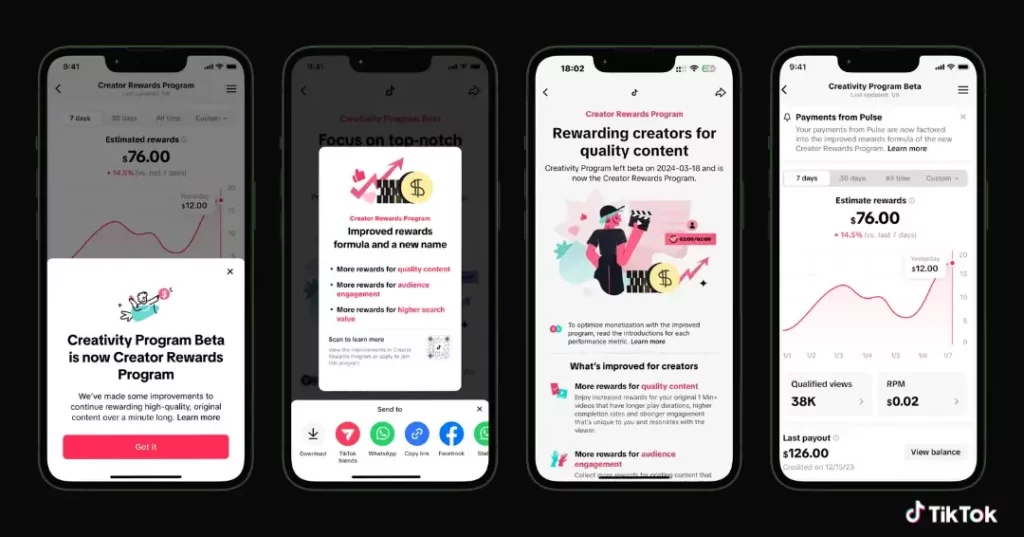
TikTok is the fifth-largest social media platform, with over 1.5 million monthly active users. It’s particularly popular among GenZers who share short-form videos regularly. It is also responsible for most of the viral pop culture trends we’ve seen lately, including the Wednesday and Water dance challenges.
Pros
- Live stream for connecting with your audience via real time video broadcasts.
- Filters and effects for creating eye-catching content
- Duets and stitches for collaborating with other creators and brands
- Video editing features like voiceovers for content personalization
Cons
- TikTok’s algorithm changes frequently, which can affect a creator’s visibility and ability to grow their audience.
- You cannot benefit from many of its monetization options as a beginner creator
Earning potential
Apart from independently sourcing brand partnerships and influencer collaborations, there are other ways to make money as a TikTok creator, including:
- TikTok Creator Marketplace: If you have over 100,000 followers, you can join TikTok’s Creator Marketplace. This is the official hub for connecting creators with brands looking for influencers for user-generated content campaigns. You also need to meet other criteria like having over 100,000 video likes in the last 28 days.
- Audience gifts: TikTok also allows eligible creators to receive video gifts and diamonds from their audience as payment for their content. To qualify, you’ll need to have at least 10,000 followers and live in a location where video gifts are available.
- TikTok Creator Rewards Program: Another way to earn is to sign up for the TikTok Creator Rewards Program. It pays up to 20 times more than the discontinued Creator Fund Initiative and is available in more than five countries, including Brazil and Japan. But you’ll need to have at least 10,000 followers to qualify for it.
- TikTok Series: You can create paywalled content on your TikTok account. These are typically exclusive videos (up to 20 minutes long) that your followers can pay to watch.
Learn more: How to make money on TikTok
3. Getty Images: Best for photographers and videographers
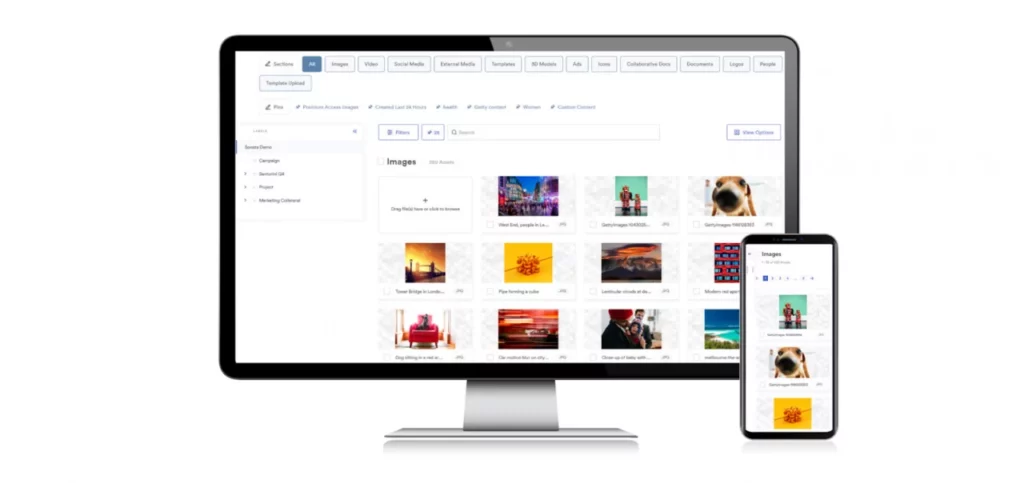
If you’re a freelance photographer or videographer, you can earn extra income as a Getty Images contributor.
Getty Images is one of the world’s largest stock photography and image licensing platforms. It provides royalty-free content for commercial uses, including marketing campaigns and creative projects.
The process is pretty straightforward. Contributors submit original media files to Getty Images’ searchable database. If a client wants to use your image or video, they’ll buy a license from Getty, and you will earn a commission from the sale.
Pros
- Global reach, exposing your images and creativity to a diverse client base.
- Creators retain the full ownership rights of their images.
- Earn compensation for images included in Getty Images’ AI training data
Cons
- You have no control over Getty Images clients’ use of your images and videos. You only retain ownership rights.
- There’s a lot of competition on the platform due to the number of images and contributors
Earning potential
As a Getty Images contributor, you’ll earn between 15 – 45% commission on every image a client purchases a license agreement for. You’ll also receive compensation for images used for generative AI training.
4. Uscreen: Best for video content creators with membership communities

Uscreen is a live-stream-focused platform tailored specifically for video content creators. Uscreen lets you host and share content with a custom website and over-the-top (OTT) apps. Integrated email marketing and app notifications also help you inform your community of your current offerings.
Live stream regularly? Uscreen lets you create a catalog page showcasing your upcoming live streams so users can pre-register. All live streams feature live chat and are automatically recorded so viewers can access them on demand as soon as you wrap up. Uscreen is a comprehensive, user-friendly platform combining content distribution and viewer engagement, perfect for creators seeking alternatives to YouTube monetization.
Pros
- You have full control over your customers’ information, and you can export it easily to other platforms.
- In addition to its online video platform, Uscreen offers community tools like livestreams and challenges for engaging community members.
- It’s very transparent about pricing, so you know how much you’ll invest from the get-go.
Cons
- It’s quite expensive compared to similar membership platforms.
- Some of its features are limited. For example, viewers can’t choose to watch from the start if they join a live session in progress.
Earning potential
Uscreen offers two self-serve plans, Basic and Growth. The Basic plan is $79 per month, and the Growth is $159 per month, each without the annual subscription discount. Unfortunately, Uscreen does limit video storage to 50 hours for Basic users and 150 hours for Growth users, so you may find yourself removing old videos or paying for additional storage once you reach the limit.
When it comes to actually monetizing your content, Uscreen excels. Creators can offer custom subscription plans with different billing cycles. And to encourage new signups or reward loyalty, you can also offer free trials and coupons. You can restrict new live streams to subscribers, one-time paid viewers, rental fees, or all of the above. Overall, we think the earning potential is pretty high here.
5. Udemy:Best for video course creators
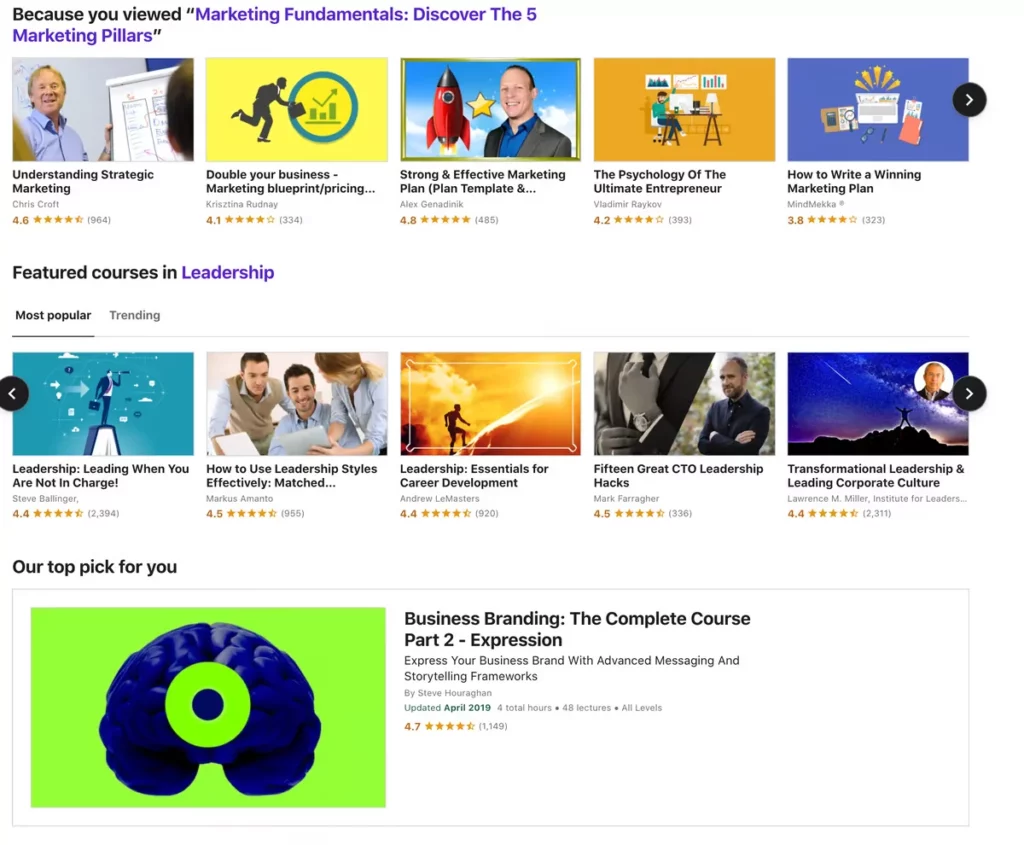
Udemy is an online learning platform that doubles as a video course marketplace. It lets creators host their online courses for free to connect with potential students and make money. This is a game changer for newbie creators who don’t have a large audience or resources for marketing their content.
Pros
- Get your content in front of over 40 million students globally.
- No upfront costs, so you won’t spend any money on course hosting and marketing
- Udemy has a dedicated marketing team that promotes courses to its audience.
Cons
- Udemy charges a high commission fee on sales made through its in-platform marketing activities.
- It has limited course design and customization options.
- Udemy doesn’t give you access to student data, which is important for building a strong learning community as a creator.
Earning potential
Udemy does not charge upfront fees to create and host a course on its platform. Instead, it operates a revenue-sharing model. This means it deducts a percentage of the course sales revenue as a commission.
If a sale occurs through your personal marketing efforts, such as a referral link on your website, you’ll receive 97% of the revenue. But if occurs through Udemy’s marketing activities, you only get 37% of the revenue.
You can also sign up as a Udemy Business Instructor to earn commissions based on your course’s total watch time.
6. Patreon: Best for micro-influencers with membership communities

Founded in 2013, Patreon is a tried-and-true monetization platform for video content creators. Using the custom creator page, you can create a space that represents your unique brand. Patreon also offers comprehensive analytics so you can understand your members and how they interact with your content.
Like Thinkific, Patreon understands the importance of engagement. The platform lets you engage with your patrons through posts, direct messages, and email. The platform also understands the importance of mobility, so you can manage your business anywhere from within the Patreon mobile app. And with unlimited app integrations, you can use the platform with your favorite marketing tools, streamlining your workflow.
Pros
- You can set up membership tiers to cater to a diverse fan base.
- Patreon provides community engagement tools to help you build personalized relationships with your fans.
- You enjoy full creative freedom over your content type and format.
Cons
- Poor user experience for creators and fans
- High fees
Earning potential
Patreon offers its services without any upfront costs, so you can get started today without handing over your hard-earned money first. As for pricing, Patreon provides three plans. But rather than charging a flat rate, you’re charged a percentage of your monthly revenue on the platform. Those percentages are 5%, 8%, and 12%.
As a creator, you can offer gated content, member-only live streams, and limited-time offers. Still, Patreon limits creators to a subscription monetization model, meaning there are no one-time payments, installments, pay-per-views, or rentals.
On the bright side, once you start earning money on the platform, Patreon allows you to pay yourself whenever you want, using direct deposit, PayPal, or Payoneer to distribute your funds. All in all, we think your earning potential with this platform is great, even if your monetization methods are limited.
7. Vimeo: Best for selling videos online
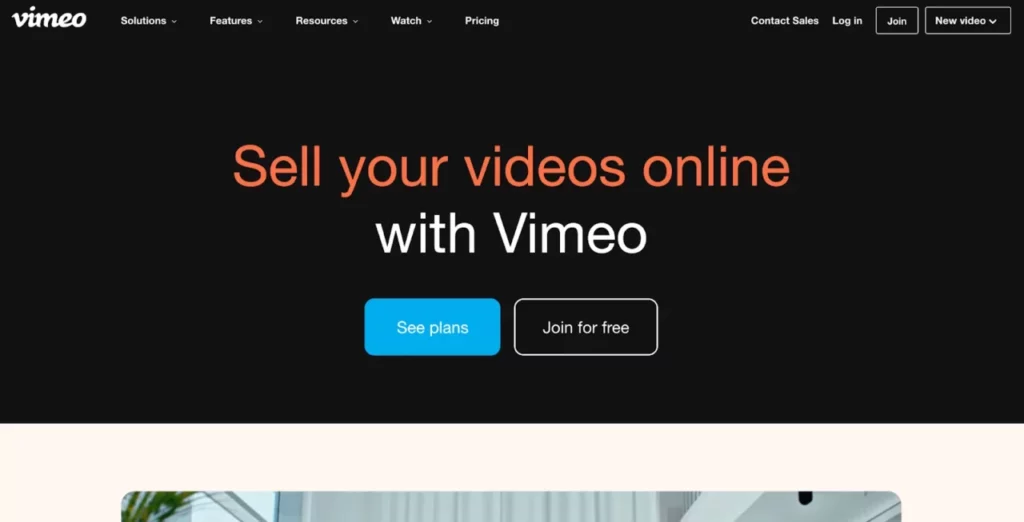
Vimeo is a video-first tool, making it a strong YouTube alternative for monetization. This service lets you add custom branded video content to an existing website, so you can keep viewers right where you want them.
Don’t have a website? Not a problem. Vimeo also lets you create a custom OTT app to sell your content and host live events, and it works with most major operating systems. Vimeo takes the technical hassle out of maintaining the mobile app experience by handling the maintenance and development for you; all you have to do is design it.
Pros
- You have more control over how people access your content. For example, you can restrict content access to only your followers or set up password control.
- It’s ad-free, which creates a better experience for viewers.
- Vimeo integrates with iMovie, Drive, and Dropbox, making it easier to upload and share video content.
Cons
- Video content on Vimeo doesn’t get as much organic traffic on search engines as YouTube.
- Its free plan has limited features, so you need to upgrade to one of the paid plans to access more features.
- Some creators find the platform too expensive, with complicated pricing.
Earning potential
Vimeo offers three affordable, self-service plans: Starter ($12), Standard ($20), and Advanced ($65). The only plan offering a month-to-month subscription is the Start plan, which costs $20 per month.
Video creators can offer free trials, free-to-view content, seasonal coupons, promotions, and even gift subscriptions. Vimeo also allows some plans to include Q&As, polls, and chats in their content. However, it’s worth noting that while Vimeo is compatible with a new or existing website, you can’t build your website directly through Vimeo like you can with Thinkific or Patreon. For that reason, we think Vimeo has serious earning potential, but it also has some challenges we can’t ignore.
8. Circle: Best for selling community subscriptions
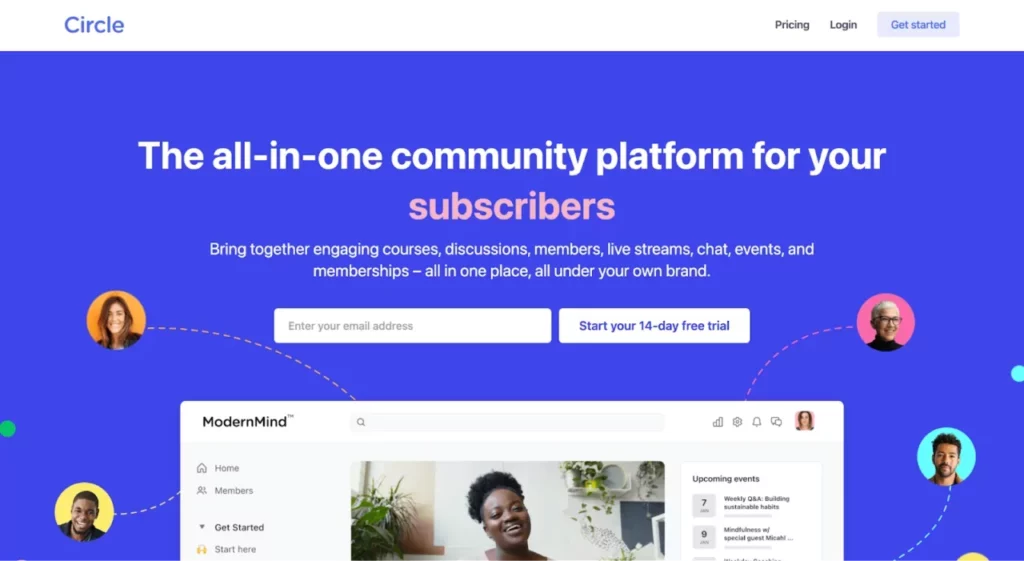
Founded in 2019, Circle is new to the scene. Circle is a community-focused platform that brings your viewers to you while also bringing them together like never before. While you can’t create your own distinct website using this platform, its white-labeling features allow you to create a custom experience tailored to your brand’s style.
Within your community, your audience can access all of your content, including live events, organized discussions, private spaces, and rich posts. A member directory allows your audience to create customized and detailed accounts so they can connect with you and each other on a deeper level. The platform also integrates with many popular tools, like Slack and MailChimp, so your workflow isn’t interrupted.
Pros
- Flexible pricing plans for communities of all sizes.
- Circle.so has an advanced analytics dashboard where you can view important data about your community, such as engagement rate, number of active members, and the like.
- You can launch a branded community app, created and managed by Circle fully.
Cons
- It has limited customization options.
- There’s no native analytics for advanced platform data.
- There’s no free plan, which makes the platform expensive for beginner creators.
Earning potential
Circle offers three self-serve plans: Basic ($49), Professional ($99), and Business ($219). The Basic plan is limited to just 100 members, but all other plans offer unlimited members. Also noteworthy, Circle limits attachment storage to 10GB for the Basic plan, 100GB for the Professional plan, and 250GB for the Business plan. While this isn’t great for creators with an extensive content library, Circle does integrate with other services like Vimeo for external video hosting.
Monetizing on Circle is easy. All you have to do is connect your Stripe account. Once you do that, you can offer paid memberships, recurring subscriptions, gated access, upsells, free trials, coupons and discounts, tiered memberships, and more. The monetization opportunities are almost limitless. And because Circle is focused on community, emphasizing your relationship with your community members, we think your earning potential is high.
9. Twitch: Best for content streaming

Twitch is a video streaming platform that allows you to deliver a more personalized experience than YouTube. What started as an online gaming platform has evolved into a streaming platform for creators of all kinds. Today, you can find exercise enthusiasts, teachers, performers, and more on the Twitch platform.
Creators can earn through ads, viewer donations, engagement, and subscriptions. However, the ability to monetize your content isn’t entirely in your hands. First, you’ll have to reach certain milestones and get accepted into one of two Twitch programs for monetization.
Pros
- Twitch is free to use, but it also offers paid premium options.
- You can share any type of creative content — from body painting to gaming and music videos.
- Twitch has over 20 million monthly active users, making it a great platform for reaching a wider audience.
Cons
- Smaller creators might struggle with getting visibility for their content.
- Twitch’s chat feature isn’t well-moderated, and sometimes opens creators up to harassment.
- There’s little or no in-platform support for newbie streamers.
Earning potential
Setting up a Twitch account is free, and you can start streaming immediately. However, to monetize your content, you’ll need to reach Affiliate or Partner status, similar to how YouTube monetization and YouTube shorts monetization work. Both tiers monetize through subscriptions, viewer interactions, ads, and donations. The higher-status Partner enjoys extended VOD storage and more free channel subscriptions for family and friends.
To earn Affiliate status, the first monetization tier, you must stream at least 8 hours over 7 days, averaging 3 views, while gathering 50 followers within a 30-day period. The Partner program has much harder requirements. For this tier, you’ll need to stream 25 hours over 12 days, averaging 75 viewers per stream over a 30-day period.
While Twitch is certainly not a replacement for YouTube, it offers a similar monetization path with even more opportunities for earning and engagement than YouTube. For this reason, we think it’s a great alternative and complement, but depending on your niche, your earning potential will likely be higher with other platforms on this list.
10. Facebook: Best for monetizing communities

Facebook is a social media platform that’s likely already integrated into your content strategy. However, Facebook for creators lets you take regular content creation on its platform to the next level. This tool allows you to manage, bulk upload, publish, and schedule your content on Facebook (and Instagram). It features an easy-to-use interface and integrates with existing Facebook groups seamlessly.
Pros
- You can create a Facebook Group for free
- Wide reach due to a global audience
- Native analytics features to help you better understand your audience
Cons
- It’s easy for your community members to get distracted by other content on the platform
- Limited monetization features
- Lack of branding and customization options
Earning potential
Facebook for Creators layers functionality onto an already useful platform, making it a great YouTube alternative for earning money. As a Facebook creator, you can earn money with ads on Facebook reels, in-stream ads, subscriptions, branded partnership content, and more.
You can customize subscriber benefits to align with your brand style and foster community. These benefits can include additional, gated video content, private posts, subscriber-exclusive Q&As and polls, and more. The fees applied to subscriber transactions can vary from 0% to 30%, depending on the payment method, so beware. Overall, we think Facebook for Creators is an awesome alternative to YouTube monetization, especially if your audience is already active on the platform.
11. Buy Me a Coffee: Best for smaller creators who want to monetize their content

Buy Me a Coffee is like Patreon for smaller creators. But in this case, people don’t have to be monthly subscribers to make donations. They can support your content whenever through one-time tips in the form of “virtual coffees.” Creators can also offer membership subscriptions to earn recurring revenue month over month as passive income.
Pros
- Creators can receive payments from their audience through various payment methods, such as Stripe, major credit cards, Apple Pay, and Google Pay.
- There is a lot of flexibility in how you monetize your content. You can receive one-time or monthly subscriptions.
- You have complete ownership over your supporters’ data, and you can export it anytime.
- There are no minimum payouts or donations. You can receive and withdraw any amount of money.
Cons
- Buy Me a Coffee lacks in-platform marketing tools, meaning you need to promote your content on other channels to get paid on the platform.
- Some creators struggle with withdrawing their earnings from Buy Me a Coffee.
Earning potential
Buy Me a Coffee has no subscription fees but charges a 5% fee on every transaction. This means you keep 95% of your earnings.
Apart from receiving one-time donations, you can set up a shop to sell digital or physical items, create memberships for recurring revenue, offer commissions for services, and even set up a Wishlist to get your items funded and earn on the platform.
12. Medium: Best for sharing and monetizing written content

Medium is a popular online publishing platform where writers, bloggers, and journalists can share their stories and ideas with a global audience. While it’s not a video hosting platform, Medium lets you embed your videos into articles to share them with your audience.
On Medium, users can create accounts, publish articles, and interact with other users by commenting on and recommending their stories. It also offers a paid subscription service where readers can access exclusive content and support their favorite writers.
Pros
- Medium has a built-in distribution system that helps your content get discovered by readers who are interested in your niche.
- You can embed videos from different platforms like YouTube and Vimeo into your Medium posts.
- Medium has a vast and engaged audience of readers and writers, which means your content has the potential to reach a wider audience.
- You own the full rights to your content.
Cons
- Medium has a Partner Program that allows writers to earn money based on engagement with their articles. However, the program has strict guidelines, and not all writers are accepted. Additionally, the earnings are not very high, which can discourage writers.
- It has limited customization features, and you have little or no control over the user experience.
- You cannot publish videos directly.
Earning potential
Eligible creators can join the Medium Partner Program. To qualify, you need to have 100 followers and live in an eligible country. Creators earn around $24 per 1,000 views or $0.024 per view. You can also embed affiliate links into your content and earn money when anyone buys a product or signs up for a service through them.
Choosing the right YouTube monetization alternatives
We’ve given you a lot to think about in this exploration. So to help find the right landing spot, let’s take a look at how to choose the right YouTube alternative for monetization. As you look at possible alternatives for your content, ask yourself these 6 questions:
- Who is your audience? If you haven’t figured out who your target audience is, now’s the time to do so. Different platforms attract different audiences. Consider where your target audience is most likely to be and what platforms will work best with your content. For example, Twitch might be perfect for you if you’re in the gaming niche.
- Are there enough monetization options? Some platforms only offer one monetization option. Others offer several ways to monetize your content. Take a moment to understand which monetization methods you’d like to utilize and what your audience would use. For example, if your content is in a higher price range, you’ll probably want a platform offering payment installments.
- Is your content compatible with the platform? All of the alternatives to YouTube monetization we’ve listed accommodate video content. Still, it’s important to consider how many videos you need to post and how large the file sizes are. Will you be posting several hour-long videos? Or a series of 2-minute videos? Different platforms have different limits on both video count and file size. Make sure the platform you choose will work with your content.
- Can this tool grow with your business? As you ask yourself these six questions, consider what the future of your business looks like too. While you might not need to host more than a few videos today, what will next year look like? Or, maybe you aren’t currently offering online courses. Does that mean you won’t in the future? Keeping monetization methods on the table will help you avoid a stressful and tedious platform move later.
- Are the policies overwhelming or straightforward? As a creator expanding from the YouTube universe, adding new policies and procedures to your content creation mix can only make your daily work more complex. Is that something you’re ready for? If not, then take a look before landing on a new platform. How does the new platform explain its policies and help creators navigate them?
- Are creators supported? This is one of the most important questions to ask. Support can look different for every creator, so take a moment to examine what kinds of support are offered. For example, call, chat, email, or phone support are all popular options. But don’t forget other alternatives like Facebook groups, Discord forums, YouTube channels, blogs, and resource libraries. What kind of support do you need to feel comfortable? Answering this question before you run into challenges may save you a lot of trouble.
Diversifying your content monetization strategy is an essential step for creators. Relying on one platform for all of your income, regardless of which platform it is, is dangerous. Of the seven YouTube monetization alternatives we’ve shown here, each presents unique opportunities for revenue generation, community engagement, and content control. Which will you choose? The digital cosmos is big and full of potential; it’s time to set a course and explore!
YouTube monetization alternatives FAQs
Find answers to common questions about alternative platforms for monetizing your video content.
1. What is the best alternative to monetizing on YouTube?
You can monetize your video content through alternative platforms like Thinkific, Vimeo, and Twitch. Thinkific is the best YouTube monetization alternative for creators selling video courses and memberships.
2. Is there any other platform like YouTube to earn money?
Yes, there are several platforms where you can earn money from your videos. If you have a video course, you can sell it using Thinkific to earn money from your students directly. You can also monetize your videos through platforms like Udemy, Twitch and TikTok.
3. What should I consider when choosing a YouTube alternative for monetization?
Content compatibility, audience, and monetization options are some of the things to consider when choosing a YouTube monetization alternative. For example, if you want to monetize your video course, platforms like Thinkific and Udemy are excellent alternatives to YouTube, as they are built for creating and selling online courses.
This blog was originally published in July 2023, it’s since been updated in May 2024.





